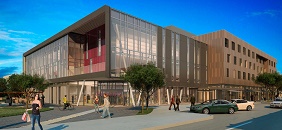 OBERLIN, OHIO—Oberlin College will soon construct a state-of-the-art hotel, restaurant, and conference center that will be named in honor of Peter B. Lewis, the late philanthropist and chairman of Progressive Insurance Co.
OBERLIN, OHIO—Oberlin College will soon construct a state-of-the-art hotel, restaurant, and conference center that will be named in honor of Peter B. Lewis, the late philanthropist and chairman of Progressive Insurance Co.
The Peter B. Lewis Gateway Center will become the cornerstone of Oberlin’s Green Arts District, an ongoing development encompassing the northeast corner of North Main Street and East College Street. The Lewis Center project is a planned 100,000-square-foot, mixed-use development that will incorporate renewable energy systems, and it is designed to meet the U.S. Green Building Council’s LEED Platinum rating. In addition to a 65-room hotel and conference center, the complex will include commercial and office space, a culinary training facility, and a restaurant featuring locally grown and sourced fare.
Oberlin College has recognized Peter B. Lewis for his $5 million gift toward the project, which is part of Oberlin’s $250 million comprehensive campaign. Lewis’gift is the single largest contribution in Oberlin’s campaign for support of the Green Arts District, and came in the form of a challenge that was successfully matched dollar-for-dollar by other donors. To date, the college has raised more than $213 million for its campaign initiatives.
Working Toward Becoming Climate Positive
“Oberlin College is profoundly grateful and honored to be included in Peter B. Lewis’ legacy of funding groundbreaking projects,” says President Marvin Krislov. “His generosity brings us a significant step closer to fulfilling our goal of becoming a climate positive community.”
The total cost of the project is estimated to be $32 million, and it will be financed with a mix of private funding and new market tax credits. Construction will be completed in four phases, during which parts of the hotel and the kitchen and dining area will remain operational. A spring groundbreaking is anticipated and the entire facility is expected to be completed and operational in January 2016.
Adam Lewis, son of Peter Lewis and a benefactor of Oberlin’s center for environmental studies, says his father wasn’t known for being an environmentalist, but he was known to be a visionary figure. “He envisioned a part of the country and the world made stronger and more resilient through green development. Though he wouldn’t live to see the realization of his vision, he was willing to initiate it.”
Locally Sourced Materials
Conceived as a catalyst for larger patterns of sustainable development and technological innovation in the Green Arts District, the Peter B. Lewis Center is envisioned to set a new standard for hotels and commercial buildings. Using locally sourced materials and thoughtful, provocative design, it will become a valuable amenity to both the campus and the community.
“Peter B. Lewis built one of the most remarkable companies on the planet—appropriately named Progressive,” remarks Oberlin College Trustee Stewart Kohl ’77, co-CEO of Cleveland-based global private equity firm The Riverside Company. “He challenged the status quo, violated unneeded norms, and never rested on a laurel. This way of life inspires much of what we do at Oberlin College and in particular the new Peter B. Lewis Gateway Center—a game-changer that will transform both downtown Oberlin and notions of hospitality and environmental performance.”
Development of the Lewis Center and the Green Arts District is integral to the long-range plans of the Oberlin Project, a joint effort of the city and college that will transform Oberlin into a model for sustainable economic development.
Both Peter and Adam Lewis have been instrumental in bringing Oberlin to the forefront of the ecological design movement, says David W. Orr, the Paul Sears Distinguished Professor of Environmental Studies and Politics and senior adviser to the president of Oberlin College. “The Peter B. Lewis Gateway Center will be a ‘Platinum’ facility. As the keystone for the Green Arts District and the vision of the Oberlin Project, it will be a milestone for the college, the city, and the green design field.”
Go to Oberlin College.





